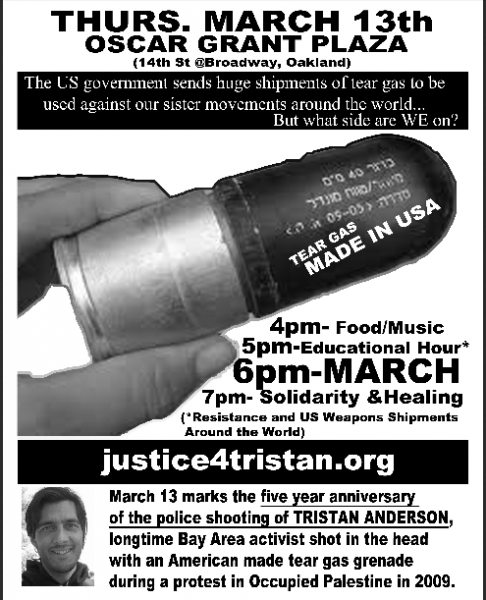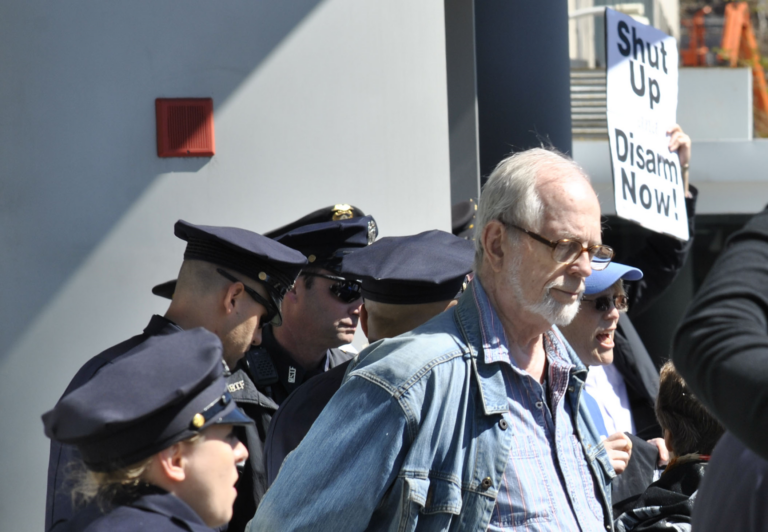Tear gas is NOT nonlethal: ways to resist US tear gas shipments
Since last week, the streets of Turkey have again been filled with tear gas following the death of 15-year-old Berkin Elvan, who was in a coma since June 2013 after being hit in the head by a tear gas canister while buying bread during the government repression of last summer’s Gezi Park uprising.
March 13th was also the fifth anniversary of US solidarity activist Tristan Anderson’s critical injury due to a tear gas canister fired at his head in a demonstration against the construction of the annexation wall through the village of Ni’lin’s land in Palestine. Tear gas is used regularly against Palestinians protesting Israeli occupation. In recent years, Israeli tear gas (made in the USA) has resulted in the deaths of Jawaher Abu Rahmah, Bassem Abu Rahmah, and Mustafa Tamimi.
We wonder how many people will be hurt and killed before we stop calling tear gas a “nonlethal” weapon?
Originally published on the WRL blog:
The Facing Tear Gas campaign stands in solidarity with the people of Palestine and Turkey in their struggle against repression and militarization and the friends and family of activists who have been killed or injured while supporting these struggles. We wonder how many people will be hurt and killed before we stop calling tear gas a “nonlethal” weapon? In the way of offering something concrete, though small, to these movements, we send a reminder about US government support to repressive regimes globally and ways to resist tear gas and other weapons shipments from inside the US, since US tear gas has been used against people around the world, including in Palestine and Turkey.
Speaking at the United Nations General Assembly in 2013, President Obama said, “The United States will at times work with governments that do not meet, at least in our view, the highest international expectations but who work with us on our core interests.” The US government gives military aid to governments and regimes, regardless of their human rights record, if it’s in the best interests of the state. No surprise there.
What you might not know is the link between the US weapons manufacturers and the US government and how tear gas and other weapons get from the US into the hands of other repressive governments throughout the world.
We compiled some of the trusted research that has been done about US tear gas shipments for a quick guide to US tear gas shipments and possible ways to resist. Thanks goes to our friends with Adalah-NY and the Global Justice Working Group of Occupy Wall Street and to journalists Anjali Kamat and Nicole Salazar for the bulk of this information. The “how to resist” section comes out of our 2 years of work on this issue through the Facing Tear Gas campaign.
How does tear gas get from American manufacturers to various governments overseas?
You could see it as a sort of triangular relationship between the U.S. government, U.S. corporations, and other governments. These three points are always involved. One thing to emphasize here is the complicity between state and corporate interests: government policies actively work in war profiteers’ favor.
Here are some of the ways by which tear gas moves from manufacturers to clients in different countries. The U.S. government’s role usually consists of one or more of the following: authorizing a sale, arranging a sale, subsidizing it, or funding it directly with taxpayer money:
First, some tear gas is transferred between governments through Foreign Military Sales, overseen by the Pentagon. The State Dept. can approve, reject, or halt any purchase. In 2012, the fiscal year racked up $69.1 billion in foreign military sales, including massive sales to the Israeli and Egyptian governments. The amount of military hardware shipped to Egypt actually increased in 2013.
Second, through Foreign Military Financing, another form of US military aid, The U.S. government does more than just approve sales. American taxpayers directly finance foreign governments’ purchases of U.S. military products via “military aid”—essentially grants and loans to foreign governments for arms purchases. In most cases, financing is available only for the sale of U.S.-made products. So, in effect, these are taxpayer-financed subsidies of private weapons manufacturers and defense contractors. In some exceptions, a recipient country can use the a limited portion of the aid to fund purchases of its own domestic products–this is the case with Israel. In 2007, the Bush Administration and the Israeli government agreed to a 10-year, $30 billion military aid package spanning from Fiscal Year (FY) 2009 to Fiscal Year 2018. During his March 2013 visit to Israel, President Obama pledged that the United States would continue to provide Israel with multi-year commitments of military aid subject to the approval of Congress Israel currently receives $3.1 billion annually in Foreign Military Financing.
Finally, there are purchases negotiated directly between the client country and the manufacturer, though Direct Commercial Sales (DCS). The U.S. State Department approves each and every one of these. Compared to Foreign Military Sales (FMS), this route is usually quicker, sometimes cheaper and always entails less government oversight. In addition, the State Department is much less transparent about DCS than the Pentagon is about FMS. Minimal information about price and quantity is classified as “confidential business information” and kept from the public. This secrecy undermines the ability of Congress and the interested press and public to exercise proper oversight on industry-direct arms transfers. The existence of these two separate programs also makes gaining an accurate count of arms exports in a given year exceedingly difficult. This is the best information we have: The top DCS totals for fiscal 2009: Egypt ($458,000 for tear gas and other riot control agents, $101 million total); Israel ($1.05 million for tear gas and other riot control agents, $602.6 million total); and Kuwait ($1.24 million for tear gas and other riot control agents, $923 million total).
Even when it’s a commercial sale, tear gas (like any other weapon) is subject to export controls, so U.S.-made tear gas cannot be shipped abroad without government approval.
What are the US companies behind the tear gas industry?
Combined Systems Inc. (CSI):
Combined Systems Inc. (CSI) calls Jamestown, Pennsylvania home. Often marketed and produced under the brand name Combined Tactical Systems (CTS), they provide tear gas to the governments of Argentina, East Timor, Cameroon, Germany, Hong Kong, India, Netherlands, Thailand, Trinidad and Tobago, Tunisia, Sierra Leone and most prominently Israel and Egypt. They say that their “OC Vapor System is ideal for forcing subjects from small rooms, attics, crawl spaces, prison cells.”
AMTEC Less-Lethal Systems Inc. (ALS):
AMTEC Less-Lethal Systems Inc. (ALS) (Formerly ALS Technologies Inc.) is based in Bull Shoals, Arkansas (to be moving to Taylor County, Florida in early 2014.) It is a subsidiary of National Presto Industries, which produces kitchen appliances and is especially known for its pressure cooker. Evidence of tear gas canisters it makes has been found in Puduraya, Malaysia.
Defense Technology/Safariland/Federal Laboratories:
Defense Technology and Federal Laboratories merged in 2001. They are owned by the umbrella company Safariland. Safariland was owned by UK weapons conglomerate BAE systems, which owns some 400 other companies, before it was bought by war profiteer Warren B. Kanders (though the sale was held up by the sentencing of a former Safariland executive for bribing government officials in Europe, Africa, and the Middle East in order to secure business). Safariland-made tear gas has been used against people in Egypt, United States, Bahrain, Palestine, Canada, Tunisia, Yemen, Mexico, Turkey, Venezuela among other places.
Nonlethal Technologies:
Nonlethal Technologies is based in Homer City, Pennsylvania. Its tear gas canisters were a regularly used weapon against the uprising in Bahrain until they were forced to stop direct sales or export by an international campaign. Nonlethal Technologies tear gas has been used in Bahrain, Greece and Turkey.
Sage Ordnance Systems Group:
Sage Ordnance Systems Group (Sage International, Ltd. and Sage Control Ordnance) is headquartered in Oscoda, Michigan. Their weapons are used in the United States, among other places.
What are ways to resist US tear gas shipments?
- Organize targeted actions against the people and companies invested in tear gas production. Kona brand bicycles, for example, is one small US consumer-based company that has chosen to continue to partner with Safariland.
- Pressure potentially sympathetic members of Congress to call for the implementation of the Leahy Law, which halts military aid to police units that fail to live up to human rights standards.
- Stop the shipments, either through campaigning for export controls through putting pressure on Congress and/or working with port workers to organize a blockade and/or picket line at the ports where tear gas is shipped abroad. In terms of recent tear gas shipments, the shipping ports have been those of Wilmington, NC and New York & New Jersey.
- Research the Port of Oakland to see if they ship tear gas and get in touch with Facing Tear Gas with what you find out! Email us at facingteargas [at] warresisters.org with any questions or go to facingteargas.org.

Share






